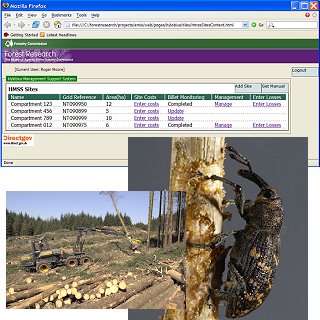The Hylobius MSS is currently unavailable online (April 2025). Updated information will appear here by the end of 2025.
Introduction
 The Hylobius MSS is a decision support system to help foresters predict and reduce damage and costs due to large pine weevil, Hylobius abietis.
The Hylobius MSS is a decision support system to help foresters predict and reduce damage and costs due to large pine weevil, Hylobius abietis.
Hylobius abietis can cause extensive feeding damage to young trees used to restock clearfell sites, but damage is often highly variable. Previously it has not been possible to predict damage and so insecticides have been routinely used to protect the trees to try to safeguard this valuable young crop. However, on clearfells where Hylobius numbers are low this treatment may be unnecessary and conversely when numbers are very high the treatment may be unable to protect the trees. Both of these situations result in losses in valuable resources.
Aims of the Hylobius MSS
- To help foresters plan future clearfell restocking strategies to minimise transplant damage by Hylobius
- To help avoid unnecessary insecticide use and initial restock failure
- To reduce top-up insecticide applications and beating up of destroyed transplants
- To help users meet operational goals for restocking and satisfy requirements of Forest Stewardship Council (FSC) and UK Woodland Assurance Standard (UKWAS)
- To reduce overall costs of restocking by helping managers make informed, site-specific decisions.
What is the Hylobius MSS?
- Until recently, the Hylobius MSS was provided to end users as user-friendly online software.
- The Hylobius MSS uses factors influencing Hylobius population size to predict damage to transplants on clearfell sites in advance of restocking.
- It is a decision support tool to allow foresters to investigate the best management strategies to reduce Hylobius damage, insecticide use and costs of restocking clearfells.
Benefits
Reduced costs of restocking achieved primarily through reduced insecticide use and reduced beat ups.
The Hylobius MSS can be used to help decide on the:
- Best time to restock sites to reduce damage
- Type of transplants (treated or untreated)
- Need to apply insecticide ‘top-ups’ and number of ‘top-ups’ required
- Most effective timing of ‘top-ups’
- Priority sites for ‘top-up’ operations in each year
- Likely effects of Hylobius control programmes
- Cost implications of these management strategies
- Compliance with stated objectives of FSC and UKWAS
- In the near future it will also be possible to predict the effectiveness of other transplant protection measures (e.g. tree guards).
The real power of the Hylobius MSS is that it is being developed to determine the effects of changes in management strategies both alone and in combination on a site-specific basis. It reduces the risks inherent in management practices based on assuming ‘average’ severity and duration of Hylobius attacks.
How it works
Basic site information, site operational costs (defaults available) and Hylobius monitoring data are input to the system. Once entered users can either investigate:
- Their preferred management strategy to achieve successful restocking or
- An ‘optimised’ strategy automatically generated by the Hylobius MSS software.
How can I access the Hylobius MSS?
The Hylobius MSS is currently unavailable online (April 2025).
Updated information on the Hylobius MSS will appear here in due course.
Help and Training
Training
Training has historically taken place annually in April/May and July just prior to the times when population monitoring should be carried out. Details of upcoming courses will be published on Forest Research’s news pages.
We hope to develop online training documentation in the future.
Monitoring package
The billet monitoring element of the Hylobius MSS can also be offered by Forest Research Technical Services Unit.
Where can I find out more about the Hylobius MSS?
Contact the Forest Research Hylobius MSS Team to subscribe or discuss your requirements and any questions you may have.
To register and subscribe or to discuss your requirements and answer your questions contact:
